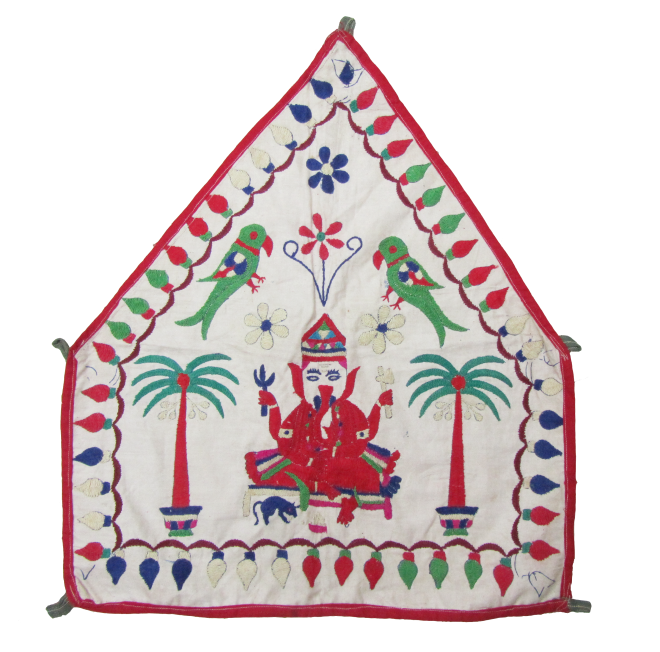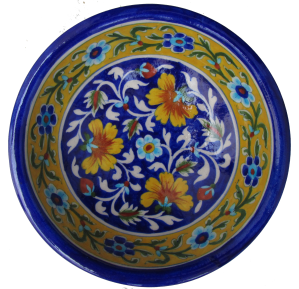
In the bygone days, arrays of items were embroidered by a bride to be, which would form a part of her trousseau. Among all these treasured articles, the most easily recognisable is the pentagonal Ganesh-sthapana.
The project of embroidering articles for the trousseau starts at a very young age with the other women of the family always lovingly lending a hand. It generally commences with the embroidering of the Ganesh-sthapana, a symbolic prayer to the Lord of obstacles for the successful completion of the mammoth project. Ganesh-sthapanas play an important role at the time of the wedding. It is installed in the family homes of the bride and the groom respectively three days prior to the wedding. Various ceremonies or pujas would be performed in front of it and when the wedding is finally completed, it would be taken with the rest of the trousseau.[i] This major role is one of the reasons, which makes it a treasured article for every woman and no matter what, never parts with it easily.
Most of the Ganesh-sthapanas are embroidered by the Kanebis of Saurashtra. Although in the recent years, other groups have also taken up the tradition. A coarse cotton fabric which is dyed in yellow or a lighter shade of orange is used for the sthapana. Plain white is also used as it symbolises purity. The fabric is shaped into a pentagonal form intended to depict a niche or a shrine. This pentagonal piece is then given to a local draughtsman who would sketch out the theme with a small twig or match stick. After this the women would embroider along the lines with floss silk threads (heer) or cotton threads of various colours. There is no limitation to the type of stitches used. A single piece can show multiple techniques. It is also embellished with mirrors (ranging from small to tin mounted big mirrors) and narrow bands of gota. The lower side of the sthapana is often decorated with leaf shaped pendants (patte) in mashru, bandhani or sometimes embroidered. There are also beaded versions (moti-bharat) of the sthapanas in the same format.
Lord Ganesh with his two acolytes Riddhi and Siddhi are lovingly embroidered, either in an abstract or slightly natural form. None of the Ganesh-sthapanas are the same, making it a highly individualistic work of art. The spaces around him are filled with parrots, peacocks, cows, his vahana, the mouse, attendants and devotees, all venerating the Lord. S.S. Hitkari in his monograph, entitled, “Ganesh-Sthapana: The Folk Art of Gujarat”, has not only documented some of the rare and interesting examples of the craft, but also decoded many symbolism that are associated with the embroidered motifs.
Ganesh appears on a square format sthapana or chauras as well made for a similar purpose. In Saurashtra he is also depicted on door valance (torans) and lintel decoration (pacchit patti) in the same delightful manner.

[i] Hitkari, S.S. Ganesha-sthapana: The Folk Art of Gujarat. (New Delhi: Phulkari Publication, 1981), 23-24.
References:
Elson, Vickie C. Dowries from Kutch: A Women’s Folk Art Tradition in India. USA: University of California Press, 1979.
Fisher, Nora, editor. Mud, Mirror and Thread: Folk Traditions of Rural India. Ahmedabad: Mapin Publishing Pvt. Ltd., 2006.
Gillow, John and Nicholas Barnard. Indian Textiles. New Delhi: Om Books International, 2008.
Hitkari, S.S. Ganesha-sthapana: The Folk Art of Gujarat. New Delhi: Phulkari Publication, 1981.
Rivers, Victoria Z. The Shining Cloth: Dress and Adornment that Glitters. United Kingdom: Thames and Hudson Ltd., 1999.
Sheth, Suresh. The Arts of the Kharak Community and Crafts of their Region-Saurashtra. Ahmedabad: Rajkalp Mudranalaya Pvt. Ltd., 2014.
